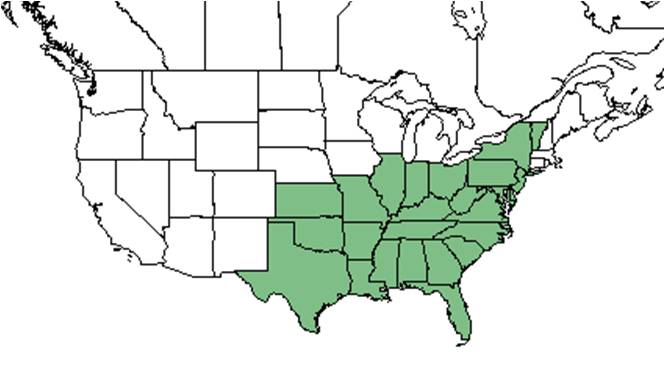Difference between revisions of "Commelina diffusa"
KatieMccoy (talk | contribs) |
KatieMccoy (talk | contribs) |
||
| Line 49: | Line 49: | ||
===Use by animals=== <!--Herbivory, granivory, insect hosting, etc.--> | ===Use by animals=== <!--Herbivory, granivory, insect hosting, etc.--> | ||
| + | The larva of the moth, ''Mouralia tinctoides'', has been observed developing on ''C. diffusa''(Landolt 1993). | ||
| + | |||
===Diseases and parasites=== | ===Diseases and parasites=== | ||
==Conservation and Management== | ==Conservation and Management== | ||
Revision as of 11:49, 9 December 2015
| Commelina diffusa | |
|---|---|

| |
| Scientific classification | |
| Kingdom: | Plantae |
| Division: | Magnoliophyta - Flowering plants |
| Class: | Liliopsida – Monocotyledons |
| Order: | Commelinales |
| Family: | Commelinaceae |
| Genus: | Commelina |
| Species: | C. diffusa |
| Binomial name | |
| Commelina diffusa Burm. f. | |

| |
| Natural range of Commelina diffusa from USDA NRCS Plants Database. | |
Common name: climbing dayflower
Contents
Taxonomic notes
Description
A description of Commelina diffusa is provided in The Flora of North America
C. diffusa is an annual species in temperate climates and is either an annual or perennial in tropical and subtropical climates [1]. Species of the genera Commelina can be separated from those of Tradescantia by having unequal petals, one is distinctly smaller (Wunderlin and Hansen 2011). Leaves are alternately arrange and develop along the nodes[2]. Flowers are actinomorphic, blue, and have three fertile stamens and two staminoids[1].
Distribution
Distribution is not limited to the Southeastern United States, it can also be found in Africa, Asia, South America, Australia, and South Asian islands (Holm et al. 1977).
Ecology
Habitat
C. diffusa can be found at loamy lake shores; sandy loam of floodplains; seasonally flooded cypress domes; annually burned pine savannas; loamy sand in mesic flatwoods; wet margins of wax myrtle thickets; and pine-oak-beech-magnolia forests (FSU Herbarium). It has occurred in disturbed areas such as the banks of artificially filled lakes, lawns, roadsides, orange tree groves, unpaved parking lots, levees and ditches. It has been observed growing in loamy sand, sandy loam, oyster shell soil, and alluvial soils (FSU Herbarium). Associated species include Alternanthera, Polygonum, Carex, Hypoxis curtissii, Paspalum, Panicum, Alternanthera, Ludwigia, Murdannia, and Hydrolea (FSU Herbarium).
Phenology
Flowers are actinomorphic, blue, and have three fertile stamen and two staminoids[1]. Blooms April through October and fruits April through September (FSU Herbarium).
Seed dispersal
The fruit is a five seeded capsule with one seed indehiscent seed in the dorsal locule and two dehiscent seeds in the ventral locule (Faden 1993).
Seed bank and germination
Fire ecology
Following a fire, adults will resprout basally [3].
Pollination
The following Hymenoptera families and species were observed visiting flowers of Commelina diffusa at Archbold Biological Station (Deyrup 2015):
Halictidae: Agapostemon splendens, Augochlorella gratiosa, Lasioglossum pectoralis
Use by animals
The larva of the moth, Mouralia tinctoides, has been observed developing on C. diffusa(Landolt 1993).
Diseases and parasites
Conservation and Management
Cultivation and restoration
Photo Gallery
References and notes
Deyrup, M.A. and N.D. 2015. Database of observations of Hymenoptera visitations to flowers of plants on Archbold Biological Station, Florida, USA.
Florida State University Robert K. Godfrey Herbarium database. URL: http://herbarium.bio.fsu.edu. Last accessed: October 2015. Collectors: Loran C. Anderson, D. Burch, Mireya D. Correa, Dianne Hall, Ed Keppner, Lisa Keppner, R. Komarek, Horace Loftin, R.L. Lazor, Karen MacClendon, Travis MacClendon, R.A. Norris, Kim Ponzio, Dana Sakole, Cecil R. Slaughter, Edwin L. Tyson. States and Counties: Florida: Bay, Brevard, Calhoun, Flagler, Franklin, Gadsden, Jackson, Jefferson, Lee, Leon, Madison, Nassau, Polk, Santa Rosa, St. Johns, Volusia, Wakulla. Georgia: Grady. Country: Panama. Compiled by Tall Timbers Research Station and Land Conservancy.
- ↑ 1.0 1.1 1.2 [Invasive species compendium]Accessed: December 9, 2015
- ↑ [Go botany] Accessed: December 9, 2015
- ↑ [Fire Responses of Commelina diffusa]Accessed: December 9, 2015